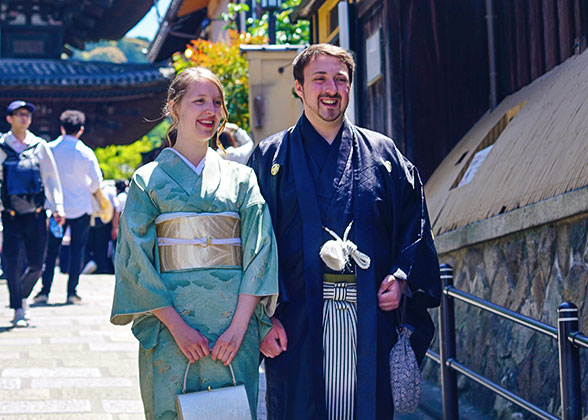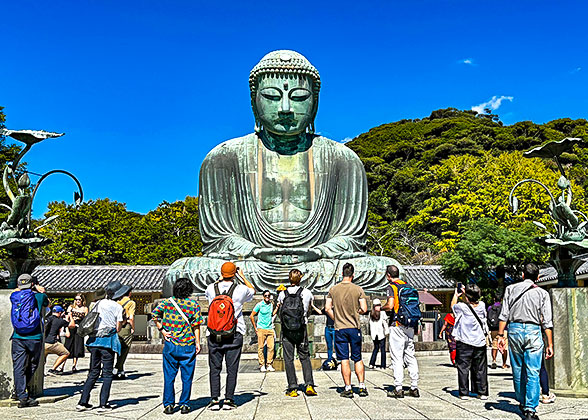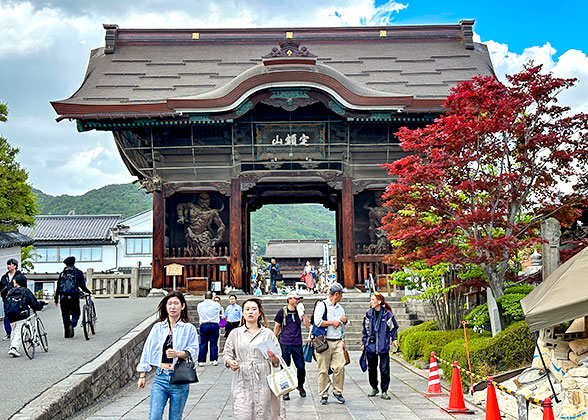Nagoya Castle
Nagoya Castle is one of “three most famous castles of Japan” together with Osaka Castle and Kumamoto Castle. It was built by Tokugawa Ieyasu, the founder and first shōgun of the Tokugawa shogunate of Japan, in 1612. In the next 260 years of the Edo Period (1603-1867), it has been the family residence of the Owari Tokugawa clan, a daimyō family founded in the early part of the Edo period (1603-1868). The original Nagoya Castle was ruined into ashes during World War II and the one we see today was reconstructed in 1959. Being the first castle in Japan designated as a national treasure, it is mainly famous for golden fish-like shachihoko statues standing on the roof of the Main Keep. As the Main Keep is not open to the public, the most striking highlight of the castle is magnificent Honmaru Palace. In addition, you can enjoy the marvelous scenery in all seasons, like cherry blossoms, Wisteria, Camellia and Peony in Spring, Camellia, Peony and Hydrangea in Summer, Japanese quince and Crape myrtle in Autumn, and Japanese witch hazel, Japanese quince, Wintersweet and Japanese plum in Winter.

Nagoya Castle Photos ( 18
|
Must-visit Scenic Spots
Honmaru Palace
Built in 1615, Honmaru Palace served as the residence of the lords of Owari Tokugawa and was used as its government agency. It was burned down in 1945 during an air attack of World War II. According to the drawings from the Edo period (1603-1867), it was on a restoration and finally regained its splendid and luxurious glory of the past in 2018.It preserves a great number of historical materials inside, including 1,047 sliding doors from Edo period (1603-1867), screens and panels designated Important Cultural Assets, 309 pre-war architectural survey and measurement drawings, 700 photographs, and around 2,000 old foundation stones.
Honmaru Palace consists of 13 buildings and over 30 rooms, among which the Omote Shoin, the main hall, and Taimenjo, the reception hall, are most famous.
Genkan- Entrance Hall

|
Omote Shoin- Main Hall
Built in 1615, Omote Shoin is the largest and noblest of all rooms. It served as the lords’ study and audience chamber, decorated with gorgeous paintings of gold and other bright colors.
Taimenjo- Reception Hall
Taimenjo was the room where the Lord met privately with his family and ministers, or held banquets. Its sliding doors and walls are decorated with artworks depicting the scenery in four seasons of Kyoto and Wakayama Prefecture, as well as the customs of local residents. The luxurious ceiling collaged with gold leaf is also a highlight.
Main Keep
|
|
|
Three Corner Watchtowers
There are three corner watchtowers: Southwestern, Southeast and Northwest Corner Watchtowers, all of which appear to be a two-story building from the exterior, but in reality there are three stories inside. Except for being used as guarding sites, these three towers were also used to resist enemies and store weapons. They are open only during special festivals. The southwestern Corner Watchtower is especially open from August 5 to 15.
|
|
|
Activities
|
Seasonal Festivals |
Activity Time |
Activities |
|
Spring festivals |
March to May: 9:00-19:30; close at 20:00 |
Cherry blossoms of Chui Sakura and Yoshino Ranai |
|
Beer tasting |
||
|
Children’s temple fairs |
||
|
Street artist performances |
||
|
Summer festivals |
August 5-15: 18:00-20:00 |
Bon Dancing |
|
August 7-9, 14, 15: 10:00-20:00 August 10-13: 16:00-20:00
|
Shachi Shokudo (Enjoy fluffy kakigori (shaved ice), ice-cold drinks, staple dishes, or local cuisine known as Nagoya Meshi)
|
|
|
August 15: 18:00-18:30
|
Matchlock Firing Demonstration
|
|
|
Autumn festivals |
From late October to late November: 9:00-16:30 |
Chrysanthemum dolls dressed in the flowers |
Tips for Visiting Honmaru Palace
1. You are required to take off your shoes upon entry, and then wear slippers provided if you are barefoot or put on stockings.2. If your luggage is relatively large, you can store it in the lockers inside the entrance. It costs none.
3. You must bear in mind that sliding doors, paper screens, and decorative mental objects are prohibited to be touched.
4. You are not allowed to use camera flash with the aim of protecting the ancient paintings.
5. You are not allowed to drink, eat, smoke and use mobile phones inside the palace.
6. For wheelchair users, please use the ramp on the north side of the palace. Special wheelchairs used inside the palace are provided.
7. It should be noted that lighting is kept to a minimum, and air conditioning and toilets are not installed.
How to Get to Nagoya Castle
By subway
You can take Meijo Subway Line and get off at Nagoyajo station. Getting out of the nearest exit, you can get to the east gate of Nagoya Castle after walking a few minutes.By bus
1. Take bus Sakae No. 13 and get off at the Nagoyajo Seimon-Mae stop;2. Take Bus No. 30, 31, 32, 33, 34, or 35 and get off at the Shiyakusho stop.
3. Take Me-guru Nagoya Sightseeing Route Bus and get off at Nagoya Castle stop.
Opening Time
Opening time: 9:00-16:30, last entry before 16:00.It closes on December 29th-31st, and January 1st.
Ticket
Adults: 500 yenChildren under 16: 100 yen




